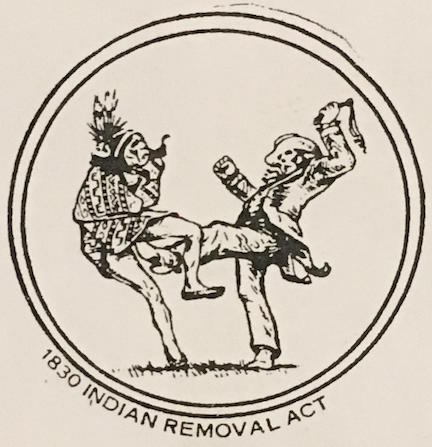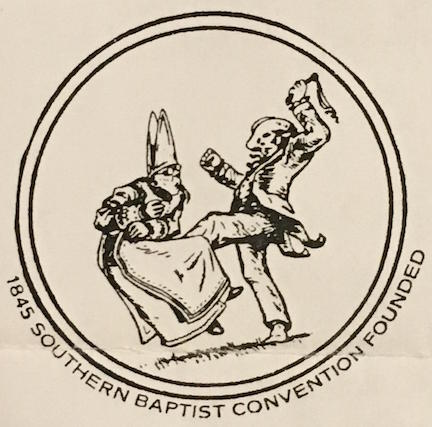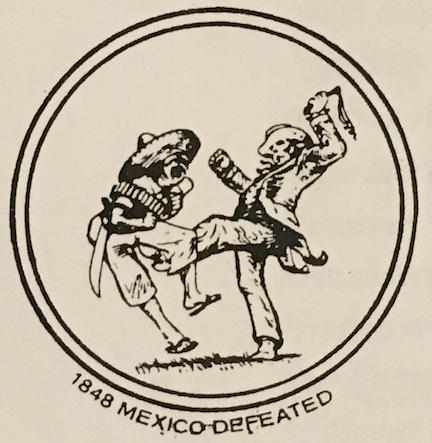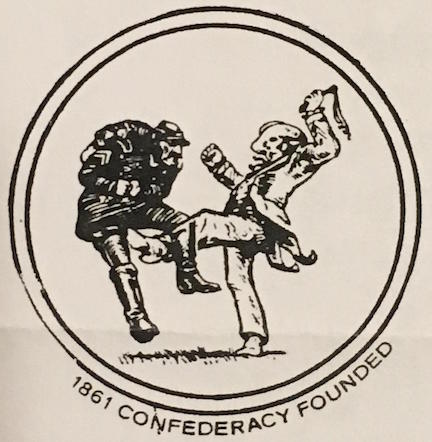Great Moments in Southern History
I sent Chris Mackowski a note on some stationery I got years ago–see below. As you’ll be able to tell, there’s a story behind it.
It was sent to me by my good friend Ben Maryniak of Buffalo. Ben and I were writing book reviews for The Courier and became epistolary companions. He wrote me a letter on this stationery. I don’t remember what he told me about its origin; a good illustrator, he might have designed it himself.
You can tell Ben had a great sense of humor, and a keen appreciation of the ironies–and sometimes lunacies–of history.
Here we see five vignettes that I call “Great Moments in Southern History.”
#1: The U.S. Congress passed an act in May 1830 providing for the removal of Indian tribes from their homelands in the eastern states. President Jackson (1829-37) pursued the policy of extinguishing Indian land titles; in his two terms, by nearly a hundred coerced “treaties,” Indian removal was implemented.
In 1845, Southern Methodists, meeting in Louisville, Ky., formed the Methodist Episcopal Church, South, after the national convention passed a resolution calling on the national bishop, a Georgian, to cease his clerical work till he freed or sold his slaves.
Not all Southerners supported the war with Mexico (Calhoun, for instance, voted against the declaration of war). But when Congress considered banning slavery from any territory that might be acquired from Mexico (Wilmot Proviso), Southerners rallied in opposition, despite the fact that southwestern lands would be unsuited to cotton cultivation.
#4: ‘Nuff said.
Ben fell ill in 2009 and died tragically of a hospital infection on May 25 at the age of 61.
He is buried in Buffalo’s Forest Lawn Cemetery. Years ago, when Ben had me flown up to speak to his Round Table, we spent a Saturday morning perambulating the cemetery. He took me to the grave of President Millard Fillmore (1800-1874). He photographed me standing beside the obelisk. I still have the picture. Every time I look at it, I think of my old friend. He’s remembered lovingly in his home town, where colleagues have renamed their Round Table the Benedict R. Maryniak Chapter.
God bless his memory.





These Illustrations from “The National Lampoon,” magazine. Somewhat amusing, somewhat offensive. Southerners did not riot when the magazine appeared.
How surprised I was to find Ben referenced when I read ECW this AM! Ben was the historical force in getting my book started about a great grandfather and great uncle who fought with the Buffalo Irish 155th. His death left a huge void in WNY historical circles and in me personally. He was that kind of charismatic guy.
Not one of Emerging Civil War’s best moments.
Ben was helping us get our museum and learning center Echos Through Time STARTED. He will always be remembered for all his knowledge,help and friendship by all he came in touch with . We do miss him up here.
Thinking #4 should be reversed.
Ben Maryniak spoke on the battle of Gettysburg at our local round table years ago. He was scheduled for three monthly meetings in a row to cover the first, second, and then third day of the battle. For the first meeting he spoke so long and the meeting went so late that the president asked him to shorten his talks up for the next two meetings. I was heartbroken! He was so interesting to listen to! I could hardly believe someone could have that much info on the battle in their head and not need notes to retell it. I especially remember him describing Brig. General Alexander Hays riding in front of his men as he dragged captured flags on the ground behind him, and Ben pronouncing Hays his “favorite maniac of the war.” He also used to narrate the annual reenactment at Genesee Country Museum from the bandstand in the middle of the great lawn. Those were good days. I wish I could have known him better than just having met him at the round table. Such a loss!
Ben Maryniak is sorely missed well beyond Buffalo. The newsletters he generated for the Buffalo Civil War Round Table were simply the best, chock-full of original research and writing and his fine artwork. Among several pleasant personal encounters I had with Ben at Buffalo CWRT talks and 154th New York descendants reunions, one that particularly stands out was a visit to the astonishing Civil War library in his home in Lancaster. It’s great to know that you and he were friends, Steve. Thanks for this tribute to a dedicated Civil War independent scholar.
Ben and I were friends for nearly thirty-five years. His knowledge of the CW was seemingly endless, as was his generosity in sharing what he knew. Likewise, he had facile and often irreverent pen. He thought highly of both Mark and Steve. His loss created a hole that will never be filled.